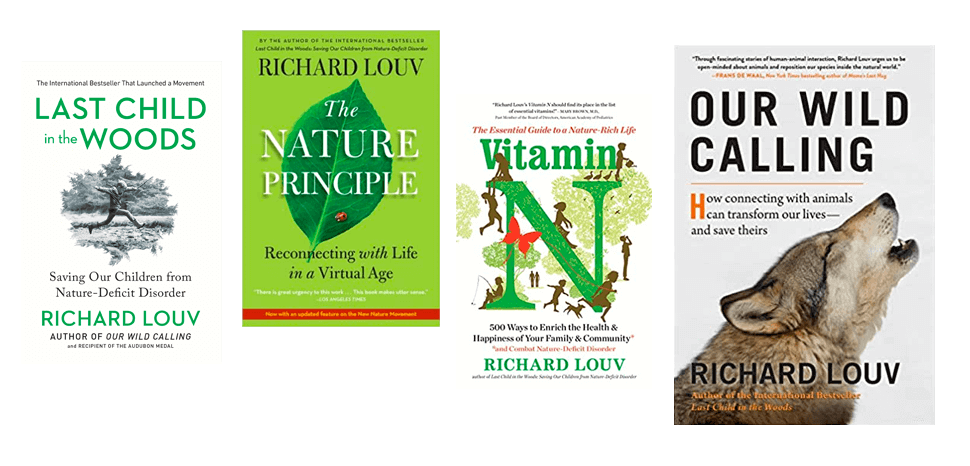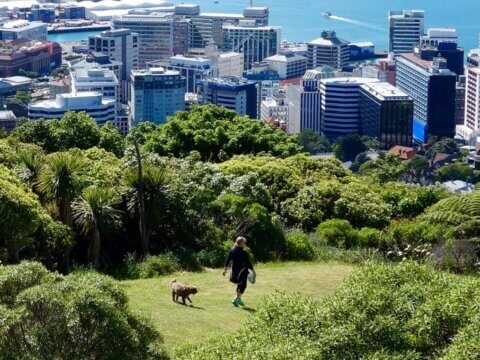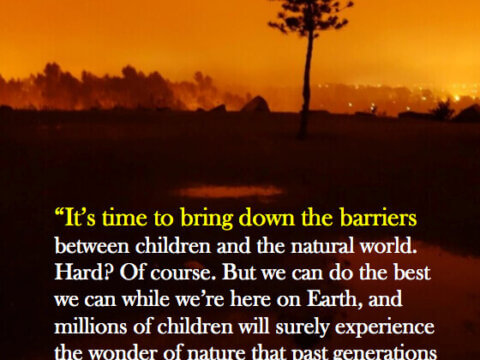HOPE BY DESIGN: Five great examples of nature-rich places to live, learn, work and play
By any reckoning, biophilic design is catching on. As the word suggests, the idea is to incorporate many more elements of the natural world into the design of schools, homes, workplaces, places of worship, neighborhoods, whole cities – from scratch or by retrofit.
Why do it? Because the growing body of subjective and scientific evidence indicates doing so enhances health, improves cognitive functioning, and nurtures the spirit — while saving energy and protecting or building biodiversity.
Proponents say that biophilic design works especially well for education, business and health care. It’s been linked to improved student test scores and greater productivity and creativity among employees; faster healing and fewer pain medications in hospitals. Many hospitals now incorporate healing gardens, but some facilities have taken the next steps to expand the benefit. The schoolyard greening movement is another expression of the trend toward nature-rich human environments.
Here are five recent next-step examples of how nature, by design, is being woven — sometimes literally — into living spaces, buildings and institutions.
The Floating Classrooms of Bangladesh: The organization Shidhulai assists children and landless and marginal farmers: “With roads impassable during the monsoon, students cannot go to school. If the children cannot come to school for lack of transportation, then the school should come to them.” Shidhulai builds or converts boats, equips them with books and computers, and powers them with solar energy. In addition to schools, Shidhulai has also converted boats into libraries, healthcare and training centers. Talk about immersion in nature. This idea could be adapted in all kinds of non-monsoon climates, as well. Think of floating classrooms on our rivers, lakes, bays. In San Diego, the coastal city where I live, more than a third of inner-city children have never been to the Pacific Ocean. Wouldn’t it be great to create a bay-based charter school — on a boat — in our neck of the sea?
The Butterfly Houses of Thailand: Soe Ker Tie Houses are play and living areas for refugee kids designed by TYIN Architects and built by local workers from Noh Bo, a small village on the Thai-Burmese border. The firm explains: “The main driving force …was to provide the children with their own private space, a place that they could call home and a space for interaction and play….The most prominent feature is the bamboo weaving technique, which was used on the side and back facades of the houses. The same technique can be found within the construction of the local houses and crafts. All of the bamboo was harvested within a few kilometers of the site. The specially shaped roof of the Soe Ker Tie Houses promotes natural ventilation within the sleeping units and at the same time rainwater can be collected and stored for the dry season…Because of their appearance the buildings were named Soe Ker Tie Haus by the Karen workers; The Butterfly Houses.” With a little pollination, this idea could spread.
The Healing Design: Minnesota’s Pioneering Children’s Mental Health Center: Steve Lepinsk, Executive Director of The Washburn Center for Children in Minneapolis and fundraiser extraordinaire Don Shelby (a Minnesota television icon) had a dream. In extreme need of a new facility, they decided a bigger building wasn’t enough – what they really wanted to create was what may become the nation’s first major mental health institution to make full use of the therapeutic power of the natural world, by design. Architect Mohammed Lawal explained the goal to WCCO, the Minneapolis CBS affiliate: “Washburn committed to a site in the city to bring nature to the city, where the kids are…So everything that we’ve done here has been about how do you enhance the relationship between the child and the therapist, and then the child and nature.” (Fair disclosure: I was asked to help in the initial stages of the design; Lawal is a member of C&NN’s board of directors.) In 2012, Washburn’s design received the first-ever Boldest of the Bold award from the Association for Corporate Growth Minnesota, recognizing “bold strategies that improved and transformed the quality of life in Minnesota.”
A Kentucky Hospital that Treats People and the Earth: In August, Audubon International reported: “The Owensboro Health Regional Hospital has recently been designated by Audubon International as the first Certified Signature Sanctuary in the state of Kentucky as well as the first hospital in the world to achieve this certification. After completing requirements and meeting the strict environmental criteria of the Audubon International Signature Program, Owensboro Health Regional Hospital also holds the distinction of being the 100th Certified Signature Sanctuary worldwide.” Among the hospital’s biophilic features: “The pond nearest the hospital, ‘The Healing Pond’, is equipped with a well water back up that will supply the irrigation system during times of extended drought. Wildlife Food – Flowering and fruit-bearing trees throughout the property provide food for wildlife. Xeriscaping – landscape architects planted drought-tolerant species to reduce the need for irrigation and maintenance.” These and other features show how a building (of standard design, at first glance), can help heal people and the planet.
The “Thicket”: Minneapolis’s Hand-made Organic Alternative to Plastic Playhouses: Okay, this woven willow playhouse is too expensive for most families, but Minneapolis designer Kelly English says the “Thicket” was inspired by “Last Child in the Woods,” so, well, I’m enthusiastic. The New York Times reports that English wanted her daughter, Clover, “to connect with the natural world,” so she built a 6-foot-tall play structure out of sticks. This comes to mind: We see growing interest in human nests woven from twigs, sometimes as tree houses, by several designers – and beyond that growing fascination with tree houses, for adults. It would be a shame if the shelters of imagination became appropriated mainly by adults (who, of course, hijacked Halloween). Wouldn’t it be great for children and the young (with a little help from their families) to weave these structures and build tree houses and other shelters themselves? One of my favorite books is the 1914 classic, “Shelters, Shacks and Shanties” by Dan Beard, one of the founders of the Boy Scouts. It’s a how-to book that teaches the young and old how to make everything from a “tree-top house to a log cabin and beaver mat hut.” All examples of the original biophilic design.
This is just a sampling of nature-rich human habitats. They’re springing up around the world. In China, for example, Friends of Nature, an NGO, is building gardens in schools for children from migrant worker families.
Please send me more examples, including what your family is doing to become nature-rich. Recently, my wife Kathy and I followed my own advice (as recommended in The Nature Principle) to reduce our nature-deficit disorder. Taking the lead, she asked a talented young landscape architect from Seattle to transform our yard into a garden of native species. We now have a whole universe of life to watch, and it’s not even on the Nature Channel.
-
Network News
POLICY UPDATE: Policy and advocacy for the children and nature movement
-
Voices
Binoculars, bald eagles and my journey as a Black birder
-
Richard Louv
THE WONDER BOWL: Ten Spring and Summer Nature Activities for Kids and Adults
-
Network News
Minneapolis Spotlight: The promise and possibilities of parks for youth
-
Voices
Why nature is my motherhood ally







Commentaries on the C&NN website are offered to share diverse points-of-view from the global children and nature movement and to encourage new thinking and debate. The views and opinions expressed are those of the author(s) and do not necessarily reflect the position of C&NN. C&NN does not officially endorse every statement, report or product mentioned.